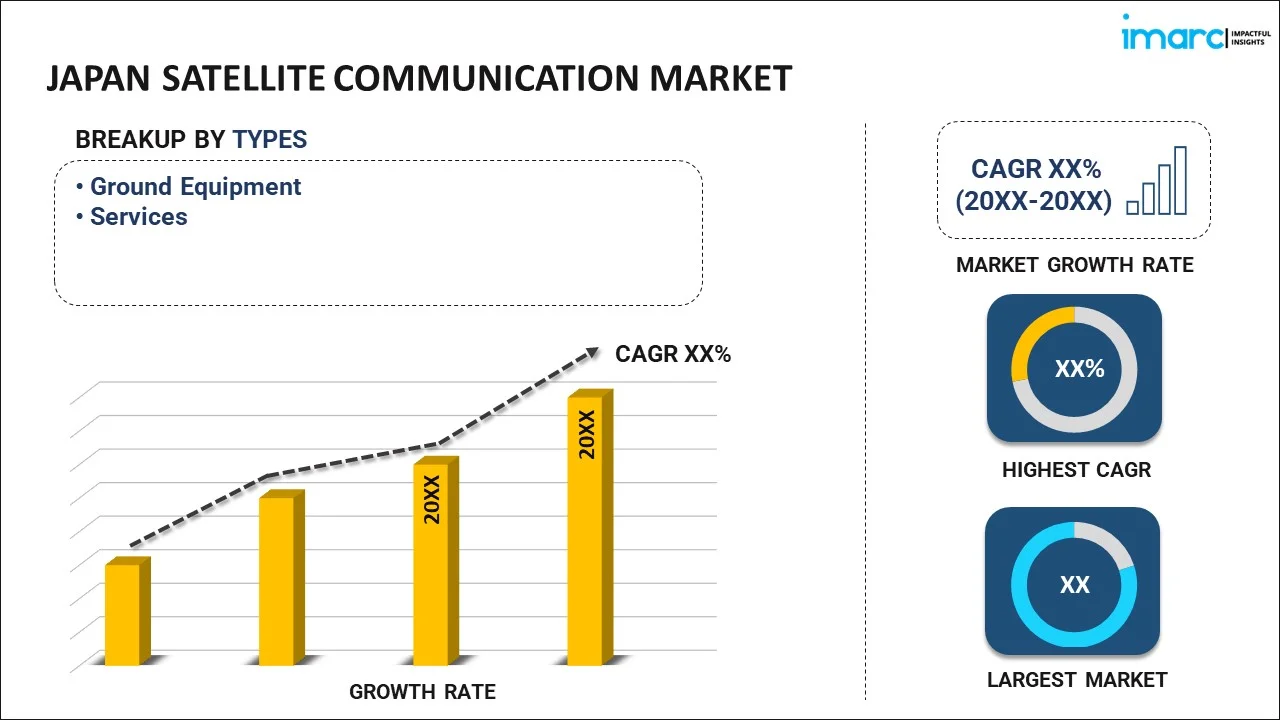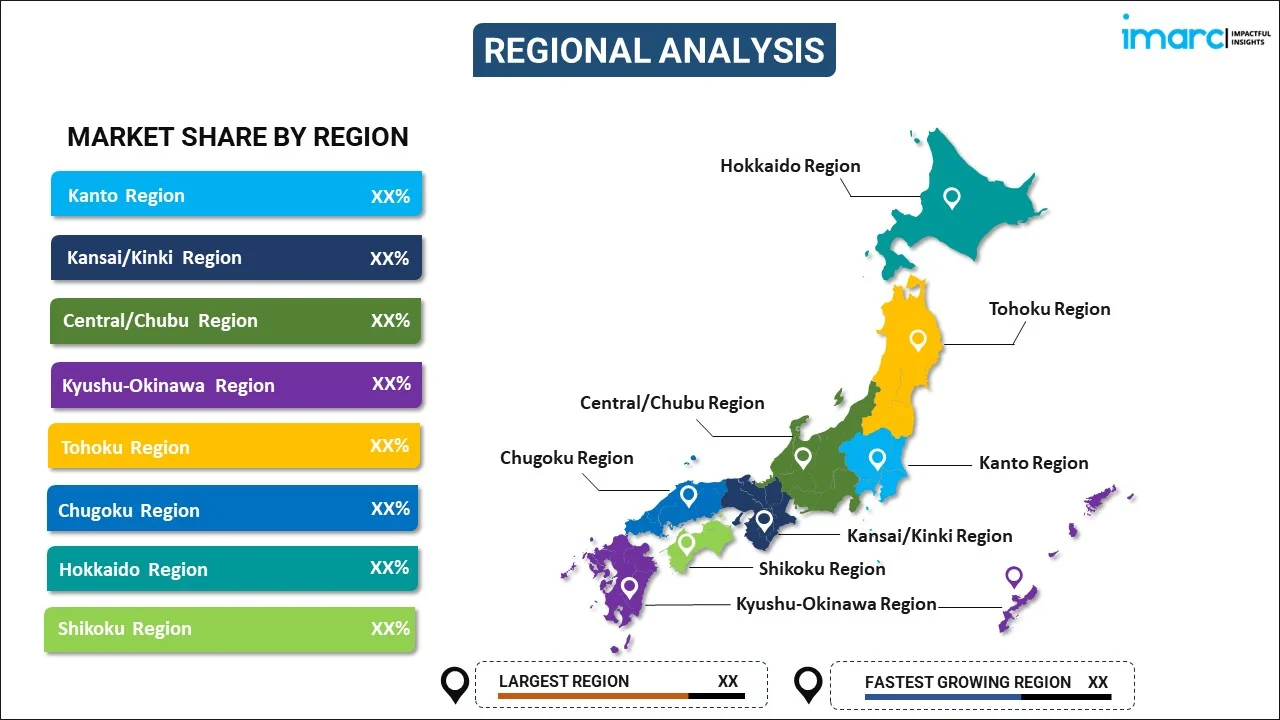
Japan Satellite Communication Market Report by Type (Ground Equipment, Services), Platform (Portable, Land, Maritime, Airborne), End Use Vertical (Maritime, Defense and Government, Enterprises, Media and Entertainment, and Others), and Region 2025-2033
Market Overview:
Japan satellite communication market size reached USD 5.7 Billion in 2024. Looking forward, IMARC Group expects the market to reach USD 17.5 Billion by 2033, exhibiting a growth rate (CAGR) of 13.3% during 2025-2033. The increasing advancements in mobile satellite services (MSS) and Internet of Things (IoT) applications, which help in tracking and monitoring of assets and vehicles in remote areas, are primarily driving the satellite communication market.
|
Report Attribute
|
Key Statistics
|
|---|---|
|
Base Year
|
2024 |
|
Forecast Years
|
2025-2033 |
|
Historical Years
|
2019-2024
|
| Market Size in 2024 | USD 5.7 Billion |
| Market Forecast in 2033 | USD 17.5 Billion |
| Market Growth Rate (2025-2033) | 13.3% |
Satellite communication, often abbreviated as SATCOM, represents a wireless means of transmitting and receiving signals across vast expanses through the utilization of man-made satellites orbiting in space. This intricate system comprises various vital components, including antennas, transmitters, receivers, user terminals, monitoring systems, and an expansive network infrastructure. SATCOM boasts a diverse array of applications, finding its presence in telecommunications, broadcasting, internet services, global navigation systems, remote sensing, Earth observation, military endeavors, scientific exploration, and rapid emergency response. One of its standout features is the ability to offer expansive coverage over wide areas, filling the communication void in regions where terrestrial infrastructure is either lacking, insufficient, or economically unfeasible. This technology is an invaluable asset, facilitating seamless and reliable communication links across distances, bridging geographical gaps, and enabling critical connectivity in scenarios where traditional means fall short. SATCOM's capacity to transcend location barriers and empower diverse sectors of society makes it an indispensable tool in increasingly interconnected regions.
Japan Satellite Communication Market Trends:
The utilization of satellite communication technology has become increasingly prevalent across various industries, particularly in maritime and aviation, where it plays a pivotal role in enhancing the efficiency of traffic operations and ensuring reliable communication between ships, aircraft, and ground stations. This widespread adoption is a significant driver of market growth. Furthermore, the agriculture sector has also embraced SATCOM for purposes such as remote sensing, weather forecasting, and crop management, which further fuels market expansion. In addition to this, the oil and gas industry in Japan has recognized the value of SATCOM for providing connectivity to offshore platforms, drilling rigs, and remote exploration sites, thereby positively impacting the market growth. Moreover, several scientific research activities, including space missions, deep-sea exploration, polar expeditions, and remote area research, have also seen a rising reliance on SATCOM, further propelling market growth. Similarly, various other factors, such as rapid industrialization, increasing demand for satellite-based surveillance, and favorable government policies, are expected to drive the satellite communication market in Japan during the forecast period.
Japan Satellite Communication Market Segmentation:
IMARC Group provides an analysis of the key trends in each segment of the market, along with forecasts at the country level for 2025-2033. Our report has categorized the market based on type, platform, and end use vertical.
Type Insights:

- Ground Equipment
- Services
The report has provided a detailed breakup and analysis of the market based on the type. This includes ground equipment and services.
Platform Insights:
- Portable
- Land
- Maritime
- Airborne
A detailed breakup and analysis of the market based on the platform have also been provided in the report. This includes portable, land, maritime, and airborne.
End Use Vertical Insights:
- Maritime
- Defense and Government
- Enterprises
- Media and Entertainment
- Others
The report has provided a detailed breakup and analysis of the market based on the end use vertical. This includes maritime, defense and government, enterprises, media and entertainment, and others.
Regional Insights:

- Kanto Region
- Kansai/Kinki Region
- Central/ Chubu Region
- Kyushu-Okinawa Region
- Tohoku Region
- Chugoku Region
- Hokkaido Region
- Shikoku Region
The report has also provided a comprehensive analysis of all the major regional markets, which include Kanto Region, Kansai/Kinki Region, Central/ Chubu Region, Kyushu-Okinawa Region, Tohoku Region, Chugoku Region, Hokkaido Region, and Shikoku Region.
Competitive Landscape:
The market research report has also provided a comprehensive analysis of the competitive landscape in the market. Competitive analysis such as market structure, key player positioning, top winning strategies, competitive dashboard, and company evaluation quadrant has been covered in the report. Also, detailed profiles of all major companies have been provided.
Japan Satellite Communication Market Report Coverage:
| Report Features | Details |
|---|---|
| Base Year of the Analysis | 2024 |
| Historical Period | 2019-2024 |
| Forecast Period | 2025-2033 |
| Units | Billion USD |
| Scope of the Report | Exploration of Historical and Forecast Trends, Industry Catalysts and Challenges, Segment-Wise Historical and Predictive Market Assessment:
|
| Types Covered | Ground Equipment, Services |
| Platforms Covered | Portable, Land, Maritime, Airborne |
| End Use Verticals Covered | Maritime, Defense and Government, Enterprises, Media and Entertainment, Others |
| Regions Covered | Kanto Region, Kansai/Kinki Region, Central/ Chubu Region, Kyushu-Okinawa Region, Tohoku Region, Chugoku Region, Hokkaido Region, Shikoku Region |
| Customization Scope | 10% Free Customization |
| Post-Sale Analyst Support | 10-12 Weeks |
| Delivery Format | PDF and Excel through Email (We can also provide the editable version of the report in PPT/Word format on special request) |
Key Questions Answered in This Report:
- How has the Japan satellite communication market performed so far and how will it perform in the coming years?
- What has been the impact of COVID-19 on the Japan satellite communication market?
- What is the breakup of the Japan satellite communication market on the basis of type?
- What is the breakup of the Japan satellite communication market on the basis of platform?
- What is the breakup of the Japan satellite communication market on the basis of end use vertical?
- What are the various stages in the value chain of the Japan satellite communication market?
- What are the key driving factors and challenges in the Japan satellite communication?
- What is the structure of the Japan satellite communication market and who are the key players?
- What is the degree of competition in the Japan satellite communication market?
Key Benefits for Stakeholders:
- IMARC’s industry report offers a comprehensive quantitative analysis of various market segments, historical and current market trends, market forecasts, and dynamics of the Japan satellite communication market from 2019-2033.
- The research report provides the latest information on the market drivers, challenges, and opportunities in the Japan satellite communication market.
- Porter's five forces analysis assist stakeholders in assessing the impact of new entrants, competitive rivalry, supplier power, buyer power, and the threat of substitution. It helps stakeholders to analyze the level of competition within the Japan satellite communication industry and its attractiveness.
- Competitive landscape allows stakeholders to understand their competitive environment and provides an insight into the current positions of key players in the market.
Need more help?
- Speak to our experienced analysts for insights on the current market scenarios.
- Include additional segments and countries to customize the report as per your requirement.
- Gain an unparalleled competitive advantage in your domain by understanding how to utilize the report and positively impacting your operations and revenue.
- For further assistance, please connect with our analysts.

 Inquire Before Buying
Inquire Before Buying
 Speak to an Analyst
Speak to an Analyst
 Request Brochure
Request Brochure
 Request Customization
Request Customization



.webp)




.webp)












